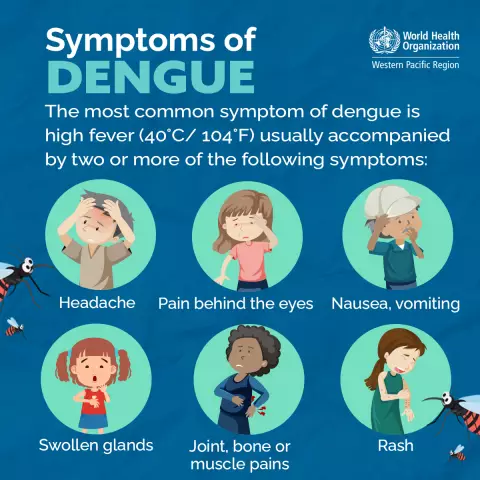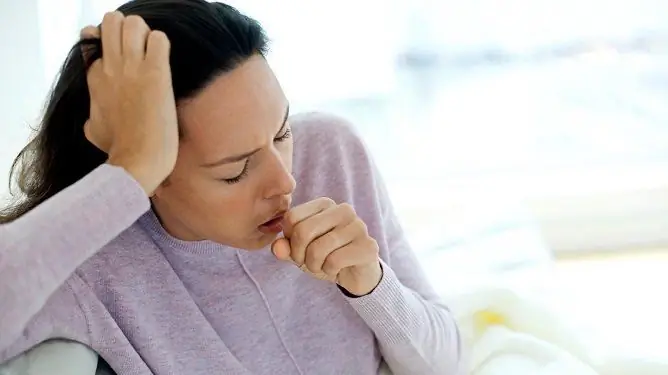- Author Rachel Wainwright [email protected].
- Public 2023-12-15 07:39.
- Last modified 2025-11-02 20:14.
Whooping cough
General information about the disease

Whooping cough is one of the most common infectious diseases. Both children and adults are extremely susceptible to its pathogens. Suffice it to say that in people with weakened immunity, upon contact with a sick person, the probability of contracting whooping cough is close to 100%.
The causative agent of the disease, whooping cough, affects only humans. Infection occurs by airborne droplets, and even an absolutely healthy person can act as a carrier of bacteria. Children of early and preschool age who have not yet acquired specific immunity are at particular risk. Note also that whooping cough in children under the age of one year is a serious danger to the life and health of the baby.
When injected into the body, infectious agents penetrate deep into the branches of the bronchial tree, where they attach to the walls of the respiratory tract and begin their destructive activity. At first, patients have only mild inflammation, but after a few days whooping cough, the symptoms of which are rapidly progressing, leads to the production of toxins. Later, they enter the bloodstream, spread throughout the body and cause serious complications. Thus, in particular, it is known that toxins irritate the mucous membrane of the respiratory tract and the central nervous system. As a result, patients become extremely irritable, cannot sleep normally at night, and lose their appetite.
Whooping cough - symptoms and clinical picture of the disease
The initial period of infection resembles a common ARI. Whooping cough patients feel:
- an increase in body temperature (usually insignificant - up to 37.5 degrees);
- slight malaise;
- rare dry cough;
- mucous discharge from the nose.
Despite the relative harmlessness of whooping cough symptoms, the patient during this period is the greatest danger to others. Even with minor contact with it, at least 90% of people susceptible to whooping cough are likely to get sick.
On days 12-14, characteristic signs of whooping cough appear. Patients develop spasmodic attacks when a strong cough is replaced by a wheezing breath, which then turns into a cough again. In severe forms, whooping cough in adults and children can cause 2 to 15 cough-inhalation cycles during one attack. The cough tremors are so strong that the patient's skin turns blue and the neck veins swell. During this period, whooping cough, the treatment of which is not controlled by specialists, can cause respiratory arrest or clonic-tonic convulsions (twitching of the whole body) in infants.
Depending on the severity of whooping cough, the affected person experiences 5 to 50 attacks per day. In preschool children, they often provoke severe vomiting. A spastic cough lasts about 1 month, after which the disease turns into a form that is not dangerous to health. True, a cough is observed during this period, but it is no longer convulsive and goes away by itself after a couple of weeks.
Whooping cough treatment

Children under one year old must be treated without fail in a hospital, where specialists will analyze whooping cough and will be able to prevent the development of life-threatening conditions in time. The hospital also treats those children in whom the infection has led to complications. Adult patients are usually treated at home, as adult pertussis rarely has any serious consequences.
What to keep in mind when treating whooping cough in children? First and foremost, parents should take care to create an environment that minimizes the likelihood of spasmodic attacks. The latter can be provoked by the most insignificant factors, from a loud conversation of adults to unexpected sudden movements. In addition, you should carefully ventilate the room in which the sick child lies.
The use of antibiotics is advisable in the early stages of the disease, when drugs are still able to suppress the development of the pathogen. If whooping cough in children has progressed to spasmodic attacks, then antibiotics will be completely ineffective.
During the treatment of pertussis in children, they take erythromycin, azithromycin, antiallergic drugs, antihistamines (pipolfen, diphenhydramine, tavegil). The dosage is chosen by the attending physician based on the patient's condition and age. Inhalation is used to thin the thick phlegm that is released during coughing, but remember that they are not recommended for children under 3 years old.
Prevention of whooping cough
Children aged 3 months to 3 years who have not had pertussis are prescribed vaccinations. The course of prevention consists of 3 intramuscular injections, which are given every 1.5 months. The vaccine either completely prevents the development of whooping cough (in 80% of cases), or prevents the occurrence of severe complications if the child is infected. When pertussis is diagnosed, treatment at home or in a hospital is carried out until the patient becomes harmless to others. In the absence of complications, this occurs approximately on the 25th day of illness.
YouTube video related to the article:
The information is generalized and provided for informational purposes only. At the first sign of illness, see your doctor. Self-medication is hazardous to health!






